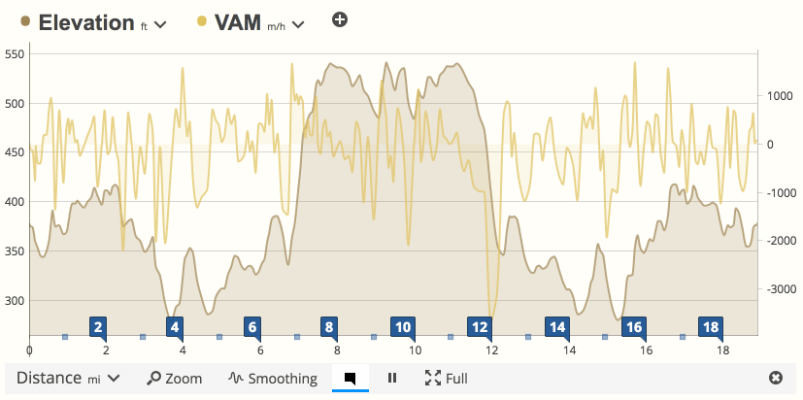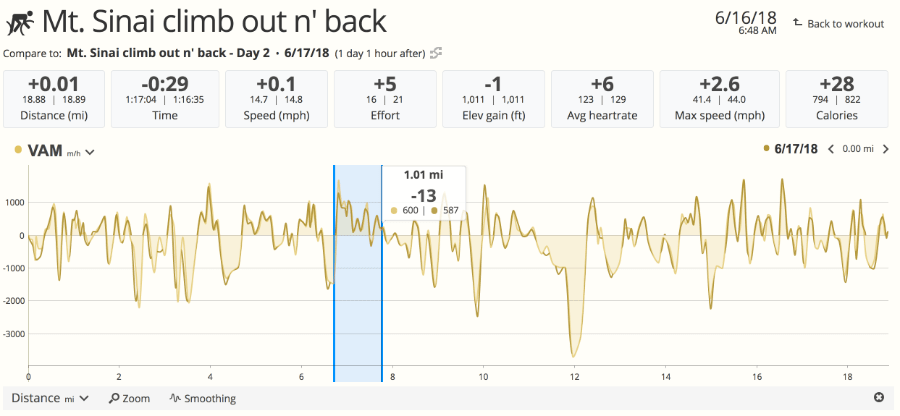New metrics were recently added to SportTracks, and among them is a tried-and-true cycling tool called VAM. In English, VAM stands for Vertical Ascent in Meters, however in Italian it's referred to as Velocità Ascensionale Media. Regardless of what the letters mean, VAM can help you improve your performance on the bike, and this post will show you how.
What is VAM?
VAM is a measure of vertical speed — not traditional horizontal speed. It's presented in vertical meters per hour (vmh), as opposed to miles or kilometers per hour. It doesn't matter if you're climbing for 10 minutes or 2 hours, your VAM speed is based on how far you would get in 1 hour. It's calculated by the vertical height you climb divided by the time it takes you to do it.

VAM is only useful when you're riding hills. Flat terrain produces meaningless VAM data. On the bright side, no special sensors or software are required to record it. You just need GPS data for the workout and SportTracks for analysis.
What do VAM scores mean? First, you need to consider the length of your climbs. Short climbs will have larger VAM scores. Steep climbs have higher scores than less-steep climbs. It becomes particularly useful when you gain an understanding of your average performance on hills that you ride regularly.
Climb Comparison
VAM can be effectively used to compare climbs. If you ride a specific climb at your strongest effort, then ride a different kind of hill at your strongest effort, you can compare your VAM scores to help determine which type of climb you were a stronger performer in.
If there's a hill that you regularly climb during workouts, you can establish your average VAM for the hill, then try to outdo yourself on subsequent workouts. The screenshot below is the Workout Comparison feature in SportTracks. A one-mile climb is highlighted. Even though I tried to beat my previous performance, my VAM was 13 meters lower. My legs weren't as fresh on the second attempt.

In addition to post-workout analysis, it's helpful monitor your VAM as you ride as well. Popular bike computers like the Wahoo ELEMNT and ELELMT Bolt make it easy to display this metric. It's also common for cycling apps to feature VAM. If there's a screen on your handlebars that displays a metric like "900 vm/h", that's your VAM and you can watch it as you climb.
Even if your bike computer, mobile app, or GPS watch doesn't record VAM, you will still be able to analyze and compare it in SportTracks because it's automatically calculated with every GPS workout. Plus, it's applied to your entire workout history.
VAM and Power
It's common for cyclists to disregard the utility of VAM when they have a power meter on their bike. While there's no question that power meters are excellent and versatile tools, there are a few scenarios where VAM becomes an important metric when you ride with power: equipment malfunction, group & team training climbs, and bike rentals (or hires).
Equipment malfunction
Power meters can revolutionize the way you ride, but they're not impervious to error. VAM is often used by cyclists who don't yet own a power meter as a surrogate for training and racing on climbs. Should your power meter fail completely, or provide numbers that seem incorrect, you can use VAM as a fallback metric to help get you up hills efficiently and competitively.
Group & team training climbs
Because power is based on the weight of the individual rider, it can't be properly used as a shared target for a group or a team ascending a hill. VAM, on the other hand, works great for this purpose. Everyone can try to hit and maintain the same number.
Bike rentals (or hires)
The power meter on your bike serves you well at home, but what if you travel somewhere with amazing hills to ride? It's often possible to rent (or hire) a bike for the day, but the chances of that bike having a power meter are less certain. If you regularly ride with VAM, you will still be able to effectively gauge your effort on the climbs.
We hope you find the new VAM feature in SportTracks useful! If you have any tips for using VAM data in training and racing, we would love to hear about it in the Comments section below...
| Article written by Sam Mallery, Director of Marketing, Zone Five Software Inc. |
